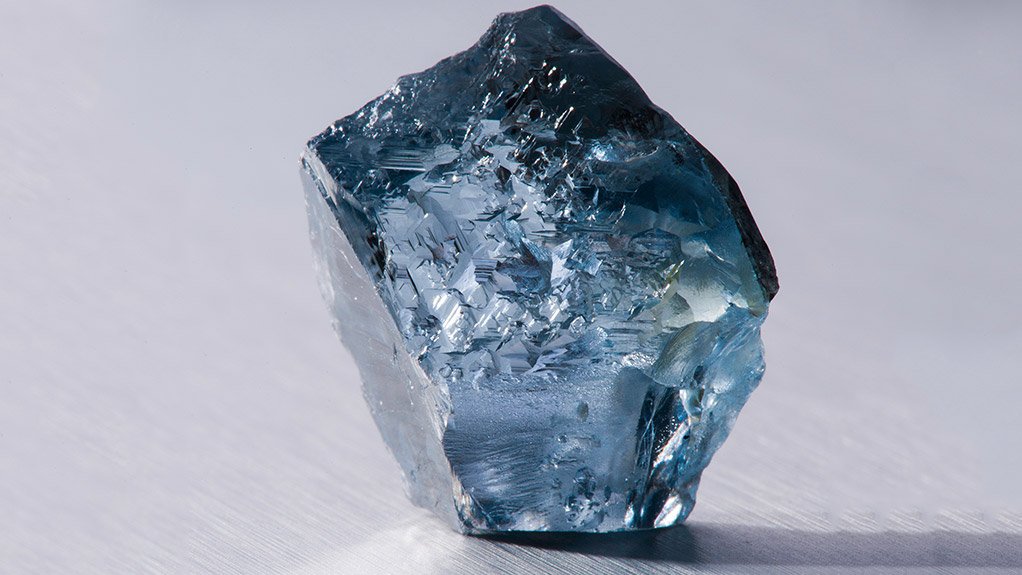Lab-grown diamonds diverging as a separate product category – Petra
Diamond miner Petra Diamonds has pointed out that laboratory-grown diamonds (LGDs) are diverging as a distinctly separate product category with a lower price point that can work alongside the natural diamond product category to grow the overall diamond market.
The company says the production capacity of LGDs globally has increased significantly in recent years and will likely continue to increase for at least the next few years.
As a result, prices have decoupled from those of natural diamonds and declined in line with scaled up production and lower production costs.
As such, LGD jewellery demand grew by an estimated 38% last year, while like-for-like prices retreated by 20%.
The company said that, especially at lower price points, LGDs were creating incremental demand that would not otherwise exist.
Aside from their pricing and value, Petra points out that there are several other considerations to take into account regarding LGDs.
Firstly, it should be noted that LGDs are manufactured within weeks through one of two manufacturing processes – the chemical vapour deposition method or the high pressure, high temperature method.
Both manufacturing processes are energy-intensive, which means that, in areas reliant on fossil fuels, their carbon footprint is significant.
More than 60% of LGDs are produced in China and India, where the manufacturing process provides opportunities for job creation and support of local communities in ways that are different to those of natural diamonds.
Petra also notes that a precedent exists with regard to other gemstone types, where man-made versions exist but sell at a considerable discount to the natural versions.
Natural diamonds, by comparison, were formed over billions of years, with each one being unique and rare, Petra says.
Moreover, diamond-bearing kimberlites are very uncommon. Of 6 800 sampled kimberlites globally, only 60 are economically viable, with only seven – including the Cullinan mine – being classed as Tier-1. The criterion for this tier is that the resource must house at least $20-billion in reserves.
The yearly recovery of 1 ct diamonds would only be enough to fill an average-sized pilates ball, Petra says, while the total number of 5 ct diamonds would only fill a basketball.
It is this rarity, natural beauty and strength that has made natural diamonds synonymous with gift-giving, while LGDs are increasingly being geared towards industrial applications.
CURRENT MARKET AND OUTLOOK
Petra says it is on track to deliver a “substantial” increase in diamond production from this year onwards, from a 2.75-million- to 2.85-million-carat low this year to an expected 3.6-million to 3.9-million carats in 2025.
This increase in production is a result of projects that are under way at Cullinan mine to optimise the orebody and mitigate the impact of C-Cut waste ingress, along with steps being taken to increase throughput at Finsch. Moreover, production at Williamson, in Tanzania, is expected to resume in the first quarter of next year.
Petra says it has witnessed the temporary softening of demand in the upstream market over the past few months.
In May, Botswana government-owned diamond trading company Okavango Diamond Company sold $56-million worth of rough diamonds at auction, in what was the company’s lightest sale since the height of the pandemic in mid-2020. Only 68% of the lots on offer were sold.
Moreover, a sampling of price changes showed that most categories were down a mid to high single digit percentage relative to a month ago.
Petra also notes that diamond mining major De Beers was reportedly combining its near-term auctions, thereby reducing the number of sales this year owing to the current lacklustre market demand for rough diamonds.
As a result of the softened demand, Petra has deferred its Tender 6 from June until August, hoping for stronger seasonal demand. This follows the withdrawal of a portion of its Tender 5 goods in May, which were predominantly higher-value goods.
Across the diamond market, midstream inventories are currently high during this period of typically lower seasonal demand, Petra says.
Diamond midstream technology and equipment provider Sarine has said its first-quarter revenue fell 12% year-on-year to $12-million. Management attributed the softer quarter in part to the inventory of polished diamonds rising significantly, which led to a decrease in the flow of new rough diamonds into the pipeline.
However, the downstream market remains robust, Petra says.
Luxury conglomerate Richemont, the parent of high-jewellers Cartier, Van Cleef & Arpels, and Piaget, posted another record quarter, with jewellery sales growing 27% in the first quarter. This performance was attributed to strong demand for jewellery, especially branded jewellery, which Richemont expected to grow.
Petra says its product mix is geared toward robust growth demographics while the number of producing diamond mines globally continues to contract.
The company pointed out that planned closures outstripped the addition of new diamond mines. Several major diamond mines, accounting for about 15% of global supply – Ekati and Diavik in Canada, and Nyurbinskaya and Almazy-Anabara in Russia – are expected to be depleted by 2030.
Meanwhile the smaller Koffiefontein and Zarnitsa mines, in the Free State and Russia respectively, are on care and maintenance, and are also expected to close by about 2025.
The Luaxe mine, in Angola, is the only major new diamond mine under construction and is expected to come on stream in 2023/24.
In terms of exploration trends, Petra noted that global exploration investment is estimated to be at multi-decade lows.
Comments
Press Office
Announcements
What's On
Subscribe to improve your user experience...
Option 1 (equivalent of R125 a month):
Receive a weekly copy of Creamer Media's Engineering News & Mining Weekly magazine
(print copy for those in South Africa and e-magazine for those outside of South Africa)
Receive daily email newsletters
Access to full search results
Access archive of magazine back copies
Access to Projects in Progress
Access to ONE Research Report of your choice in PDF format
Option 2 (equivalent of R375 a month):
All benefits from Option 1
PLUS
Access to Creamer Media's Research Channel Africa for ALL Research Reports, in PDF format, on various industrial and mining sectors
including Electricity; Water; Energy Transition; Hydrogen; Roads, Rail and Ports; Coal; Gold; Platinum; Battery Metals; etc.
Already a subscriber?
Forgotten your password?
Receive weekly copy of Creamer Media's Engineering News & Mining Weekly magazine (print copy for those in South Africa and e-magazine for those outside of South Africa)
➕
Recieve daily email newsletters
➕
Access to full search results
➕
Access archive of magazine back copies
➕
Access to Projects in Progress
➕
Access to ONE Research Report of your choice in PDF format
RESEARCH CHANNEL AFRICA
R4500 (equivalent of R375 a month)
SUBSCRIBEAll benefits from Option 1
➕
Access to Creamer Media's Research Channel Africa for ALL Research Reports on various industrial and mining sectors, in PDF format, including on:
Electricity
➕
Water
➕
Energy Transition
➕
Hydrogen
➕
Roads, Rail and Ports
➕
Coal
➕
Gold
➕
Platinum
➕
Battery Metals
➕
etc.
Receive all benefits from Option 1 or Option 2 delivered to numerous people at your company
➕
Multiple User names and Passwords for simultaneous log-ins
➕
Intranet integration access to all in your organisation





















